“Wait, what? We’re taking an exam to get into medical school. Why do I have to go back to learning math? Plus, I thought math was just numbers. Why are there letters?!” 
Unfortunately, to our dismay, we sometimes still have to get the dirty stuff done just to make ends meet. While not exactly MCAT content material, understanding some of the basics of MCAT math will be undoubtedly beneficial as you’ll undoubtedly encounter a fair amount of calculation questions!
Hopefully, after reading through this article, you’ll have a superficial understanding of units and dimensional analysis before diving further into the individual articles. Let’s go!
Units and Dimensional Analysis on the MCAT: What You Need to Know
Topics on units and dimensional analysis will be realistically tested in all the MCAT sections except for the CARS section!
While we cannot give you a good probability of the number of unit and dimensional analysis questions, know that they’ll most likely be asked in the context of general chemistry and physics topics.
Introductory physics accounts for 25% of the content covered in the Chemical and Physical Foundations of Biological Systems.
Important Sub-Topics: Units and Dimensional Analysis
As cliche as it sounds, your practice and amount of exposure are your best weapons to becoming more comfortable with these questions! Start slow, jot down your mistakes, and progressively build confidence!
Standard Metric Units
The SI units are the primary calculation units used and tested by the MCAT! These include units like meters, kilograms, celsius, etc. (think that we’re in Europe y’all!). We’ll list just a couple down in the table below as you’ll become much more familiar as you go through different physics and chemistry MCAT topics!
Within the SI system, there are 2 main types of units: basic and derived units. Basic units are the units that the system is centered on, while derived units (as their name implies) are derived from the basic units. Note that derived units are still within the SI system!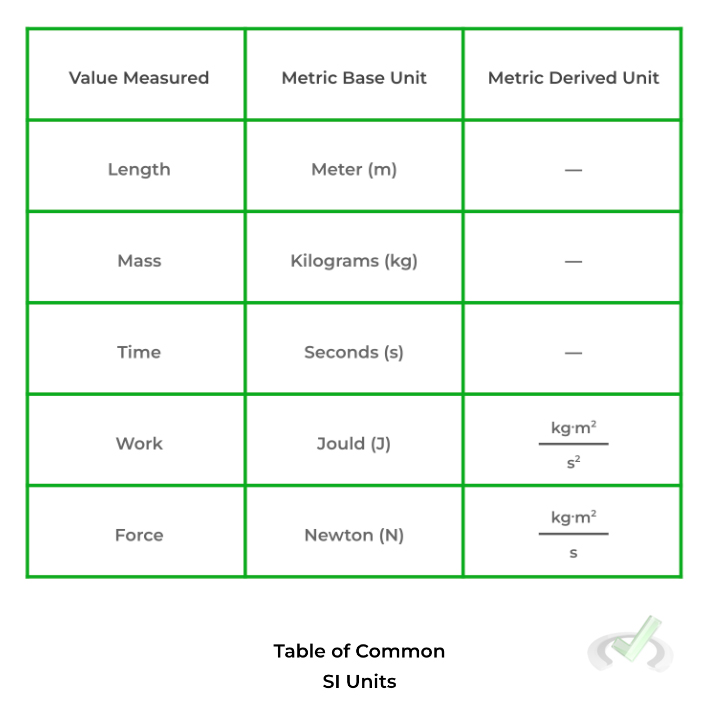
A big part and must know in regards to solving MCAT calculation problems is understanding base 10 conversion factors. Not only will you have to memorize various equations and variables, but you’ll also be expected to convert between units adding another element of difficulty!
Unfortunately, one of the only ways around this is through memorization, but as you solve lots of problems, you’ll slowly but surely become more familiar and comfortable with these conversions.
(Coming Soon!) Full Study Notes : Standard Metric Units on the MCAT
For more in-depth content review on the stand metric units, check out these detailed lesson notes created by top MCAT scorers.
Basics of Dimensional Analysis
If you’ve studied stoichiometry in general chemistry, you may be familiar with this concept already! In its simplest terms, dimensional analysis are mathematical calculations that allow you to convert between different units and metric factors.
The key to solving dimensional analysis problems is to make sure all your unwanted units cancel so that you’re left with the correct units! Look at the example below!
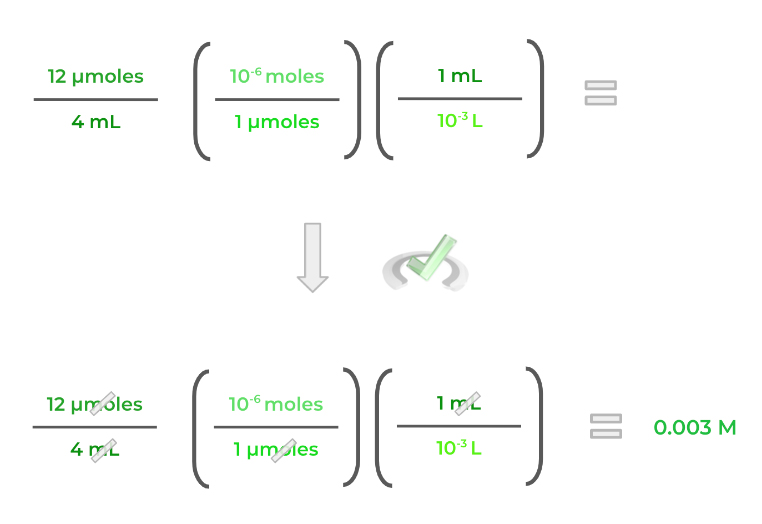
Notice how in this molarity example, everything crosses out except the desired units: moles divided by liters which gives molarity. This example shows the importance of committing the base 10 conversion factors to memory!
Apart from this common example, you’ll see a lot of dimensional analysis in topics such as stoichiometry, emission spectrums, etc.!
Learn more about dimensional analysis in this article!(Coming Soon!) Full Study Notes : Basics of Dimensional Analysis on the MCAT
For more in-depth content review on dimensional analysis, check out these detailed lesson notes created by top MCAT scorers.
Mathematical Functions of Exponents and Logarithms
Probably after seeing the base 10 conversion factors above, it may be beneficial to go over some basics of exponents and logarithms. As indicated by the topic title, we’ll focus more on the mathematical functions of the 2 rather than a basic overview.
The 2 mathematical functions of exponents most helpful for the MCAT are the multiplication and division of exponents. Remember: the base of both exponents must be the same or else the below rules cannot apply!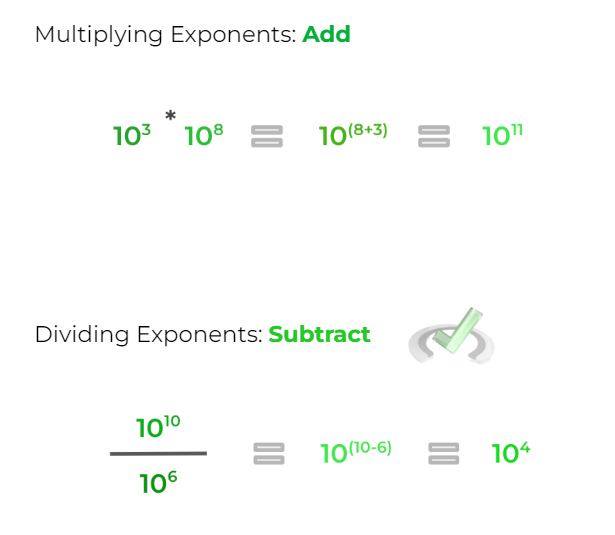
Note that both the exponents are the same: base 10. This allows us to apply the rules mentioned above!
These 2 exponential mathematical functions are the basis for solving mathematical calculations dealing with scientific notation which we’ll discuss more in the upcoming section!
Additionally, 2 important exponential rules to remember before going into the MCAT are the zero exponent and negative exponent rules.
The zero exponent rule states that any base raised to the power of 0 is always equal to 1. The negative exponent rule states that we can write negative exponent as a fraction reciprocal as shown below.
Logarithms might need a little background explanation before getting into some of the common mathematical functions. By their formal definition, logarithms are the inverse of exponents. But let’s try to explain it in a different way!
In exponents, we’re trying to find a value (y) given the base (b) raised to the power of (x). In logarithms, however, we’re now trying to find the value of the exponent (x) as we have (y) and (b).

Most logarithmic expressions you’ll encounter on the MCAT are base 10 logs (i.e. b = 10). However, there is another special type of logarithm called a natural log where the base is Euler's number, e.
Luckily, you most likely won’t have to calculate any values with the natural log. You’ll see natural logs mostly in the context of equations and really only have to memorize the following relationships!
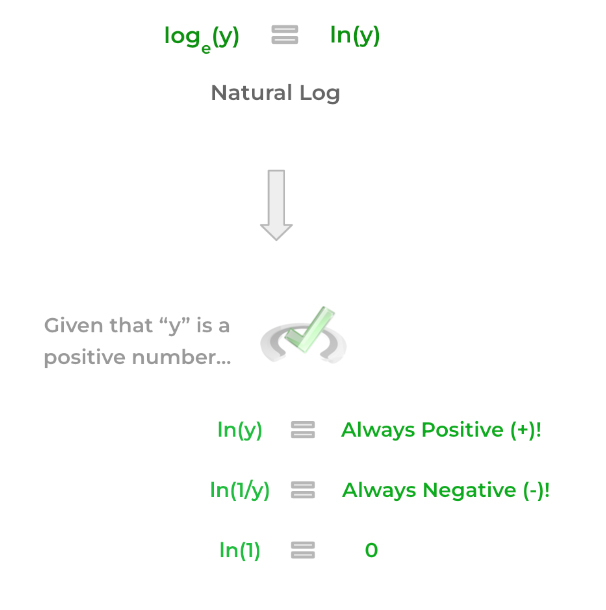
Just as a preview, the above relationships will be really useful when dealing with Gibbs free energy and reaction spontaneity!
(Coming Soon!) Full Study Notes : Mathematical Functions of Exponents and Logarithms on the MCAT
For more in-depth content review on the mathematical functions of exponents and logarithms, check out these detailed lesson notes created by top MCAT scorers.
Fundamentals of Scientific Notation
After covering the above topics, we now have a better foundation to delve into scientific notation. Simply put, you’re basically multiplying a number by a base 10 conversion which is another way of formatting a really big or small number!
The trick to getting comfortable with scientific notation is knowing 1) which direction you’re moving the decimal and 2) counting the number of decimal places you’re moving. Look at the following rules below!
>> Making a “Big Number Smaller”
Move the decimal place FROM THE RIGHT TO LEFT until you reach the desired decimal place. The number of decimal places moved will be the POSITIVE value of the exponent.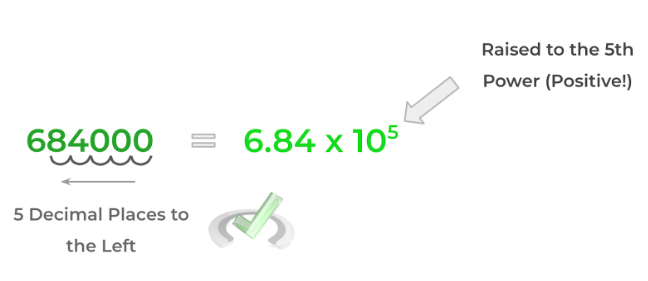
>> Making a “Small Number Bigger”
Move the decimal place FROM THE LEFT TO RIGHT until you reach the desired decimal place. The number of decimal places moved will be the NEGATIVE value of the exponent.
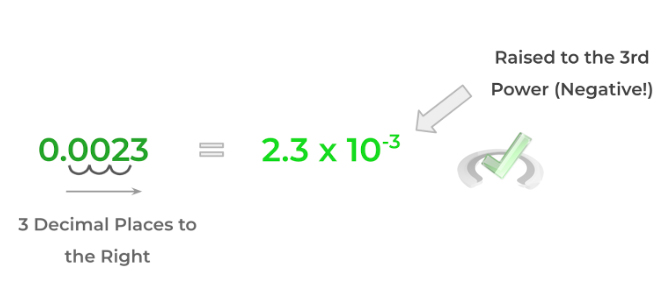
Luckily, a trick to memorizing the rules of scientific notation is that the rules are essentially opposites of one another!
(Coming Soon!) Full Study Notes : Fundamentals of Scientific Notation on the MCAT
For more in-depth content review on scientific notation, check out these detailed lesson notes created by top MCAT scorers.
Important Definitions and Key Terms
Term | Definition |
|---|---|
Basic Units | Units which the SI system is built from; Including meters, kilograms, etc. |
Derived Units | SI units are derived from basic units; Including newtons, joules, etc. |
Dimensional Analysis | Mathematical calculations that allow you to convert between different units based on a set conversion factor/ratio |
Natural Logarithm | Logarithmic function where the base is Euler’s number (e) |
Scientific Notation | Method to format very large and small numbers via multiplying a number by a base 10 conversion factor |
Additional FAQs - Units and Dimensional Analysis on the MCAT
How Do You Convert Units on MCAT?
What Units Do You Need to Know for the MCAT?
Do Dimensional Analysis Use Units – MCAT?
Do We Need to Know Unit Conversions for the MCAT?
Additional Reading: Physics Topics on the MCAT:
- Circuits on the MCAT
- Electrostatics on the MCAT
- Fluids on the MCAT
- Kinematics on the MCAT
- Light and Optics on the MCAT
- Magnetism on the MCAT
- Thermodynamics on the MCAT
- Atomic and Nuclear Phenomena on the MCAT
- Waves and Sound on the MCAT
- Work and Energy on the MCAT


 To help you achieve your goal MCAT score, we take turns hosting these
To help you achieve your goal MCAT score, we take turns hosting these